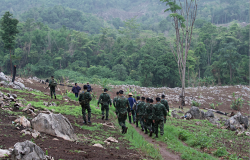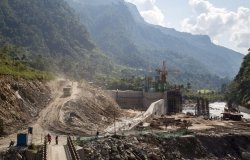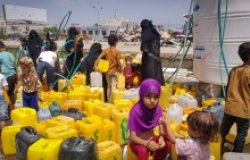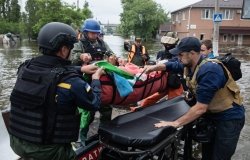<i>Environmental Change & Security Program Report</i> Wins Global Media Award
OCTOBER 2006--Population Institute to Host Ceremony at U.S. Capitol Building
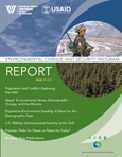 The Environmental Change & Security Program Report—the annual report from ECSP—is the winner of the Population Institute's 27th Annual Global Media Award for Best Population Journal. Along with ECSP, 10 other journalists and communicators from five countries will be honored for their outstanding contributions to greater awareness of population, environment, and resource issues. "These journalists have helped to create much-needed public awareness for population issues through their dedicated efforts," said Lawrence Smith, Jr., president of the Population Institute.
The Environmental Change & Security Program Report—the annual report from ECSP—is the winner of the Population Institute's 27th Annual Global Media Award for Best Population Journal. Along with ECSP, 10 other journalists and communicators from five countries will be honored for their outstanding contributions to greater awareness of population, environment, and resource issues. "These journalists have helped to create much-needed public awareness for population issues through their dedicated efforts," said Lawrence Smith, Jr., president of the Population Institute.
Other Global Media Award winners include Al Gore's An Inconvenient Truth for Best Film Documentary, and USA Today was named Best Major Daily. A full list of winners is available at the Population Institute website.The award ceremony will be held December 6, 2006 at the U.S. Capitol Building.
The 11th edition of the ECSP Report was named Best Population Journal for promoting dialogue on the connections among environment, health, and population dynamics and their links to conflict, human insecurity, and foreign policy. Bringing together authors from Nepal to Norway, from the university to the military, the Report explores how powerful underlying forces may engender war—or lay a foundation for peace. According to some experts in the Report, protecting natural resources and stabilizing population growth must be part of these conflicts' long-term solutions. Others say the evidence does not support this strategy. But all agree that more research will lead to a more nuanced understanding of the links connecting environment, population, and security.
The 11th edition features these special reports on population, environment, and security:
- Analyzing Nepal's deadly—and recently reignited—Maoist insurgency, Richard Matthew and Bishnu Raj Upreti state that even though environmental and population factors are not the primary causes of instability in this critical country, they are "important elements of what has gone wrong in Nepal, and they must be addressed before stability can be restored."
- The military may seem an unlikely venue for peacemaking, but as Rear Admiral John Sigler USN (Ret.) explains, environmental security engagement—particularly disaster response—is a part of U.S. Central Command's efforts to promote regional stability. "The contributions of these relief operations to U.S. security interests cannot be overstated. American national values are on display, offsetting negative perceptions of the ‘hyper-power' and promoting positive views of the United States and other western nations, which could help reduce global terrorism."
- What happens when "son preference" leaves a nation with significantly more men than women? Valerie Hudson and Andrea den Boer warn that gender imbalances in Asian countries (notably India and China) could lead to internal and regional strife, and affect those countries' democratic potential: "In many ways, a society's prospects for democracy and peace are diminished in step with the devaluation of daughters."
- Henrik Urdal finds that national levels of population growth, land scarcity, and urbanization do not have a great influence on patterns of war and peace; however, "using local level data—rather than national—might reveal a stronger relationship between population pressure and conflict."
- While youth are often singled out for their role in conflict, Sarah Staveteig proposes that a more precise measure of age structure can effectively predict insurgent-based civil wars. By studying trends in the future "relative cohort size"—the difference in the number of young adults versus the number of older working adults—policymakers could devise strategies to reduce the chances of such conflicts.
- Ethnicity carries much of the popular blame for recent conflicts, but little sustained research has explored how demographic shifts contribute to violence. Monica Duffy Toft warns that without government and academic efforts to improve the reliability and availability of data on differential population growth, aid and intervention strategies may continue to be counterproductive or destructive.
- Foundations are moving their funds from integrated programs to other priorities. But Robert Engelman of Population Action International argues that there is still a place for the demographic case: "We can improve lives by promoting with one strategy reproductive health, the demographic transition, and environmental sustainability"—if donors step up to support it.
In 2005, the 10th edition of ECSP Report won a Global Media Award for Best Population-Environment Reporting. The winning piece, "Population, Development, and Environment in Ethiopia," written by Packard Foundation program adviser Sahlu Haile, reports that Ethiopia's population growth has contributed to unsustainable farming and deforestation, thus degrading the environment and undermining development.
To learn more about ECSP's current and upcoming projects, explore our ever-expanding website, which features a topical navigation tool for sorting news, research, videos, and links according to your interests. Subscribe to our popular monthly e-newsletter, ECSP News, to receive meeting summaries, program news, and event announcements straight to your inbox.
Related Program

Environmental Change and Security Program
The Environmental Change and Security Program (ECSP) explores the connections between environmental change, health, and population dynamics and their links to conflict, human insecurity, and foreign policy. Read more
